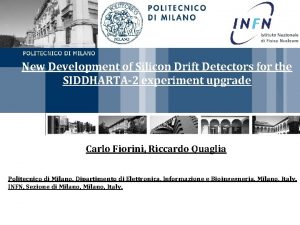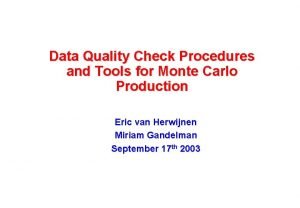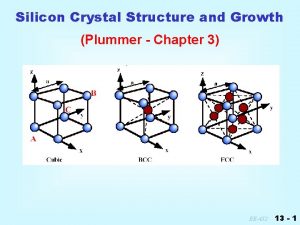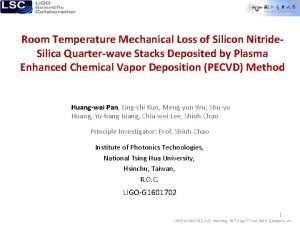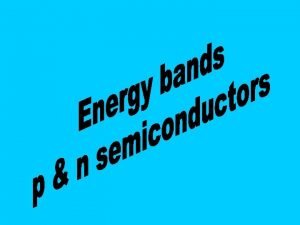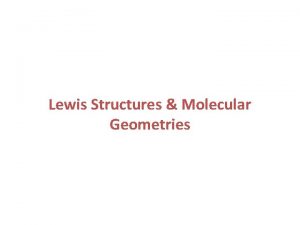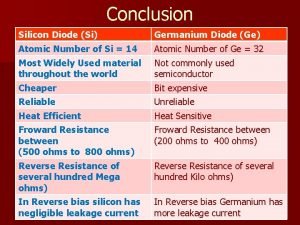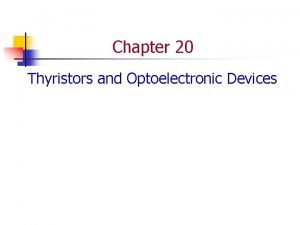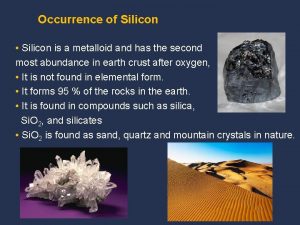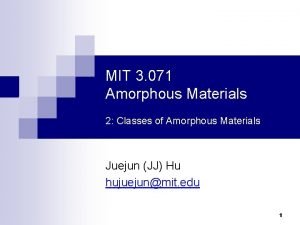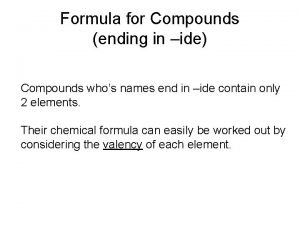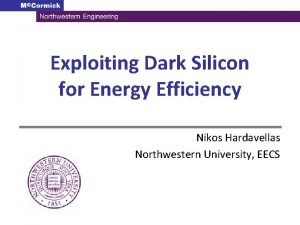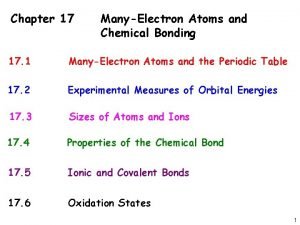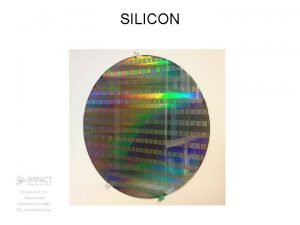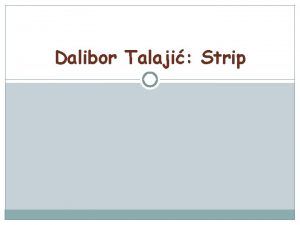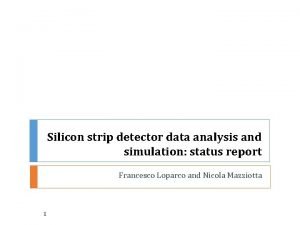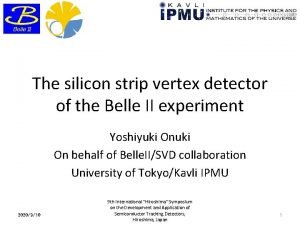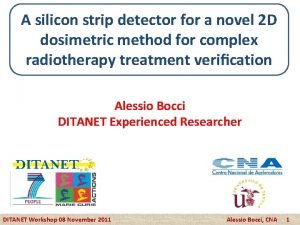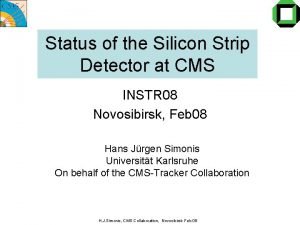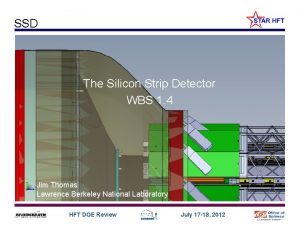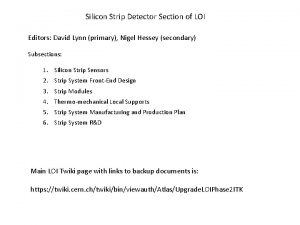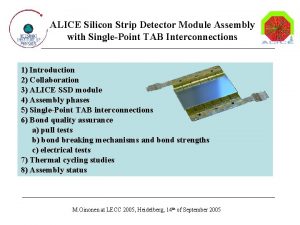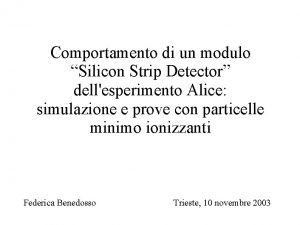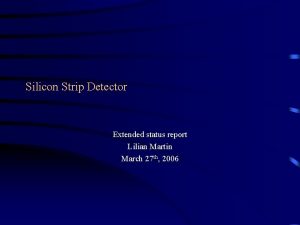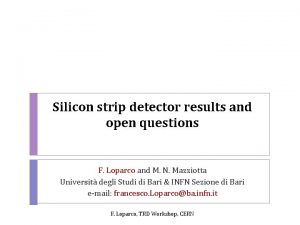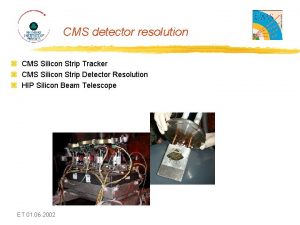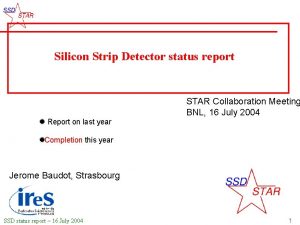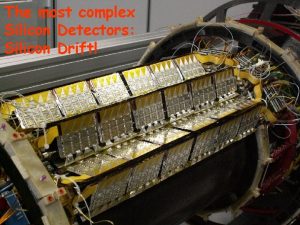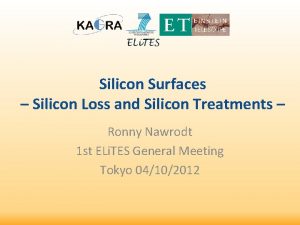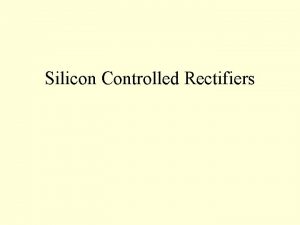Silicon strip detector comparison of data with Monte






















- Slides: 22

Silicon strip detector: comparison of data with Monte Carlo simulations Francesco Loparco and Nicola Mazziotta 1

TR spectrum (1) � 2

TR spectrum (2) � 3

MC simulation � 4

Detector simulation: noise � To each strip is assigned an energy extracted from a gaussian PDF with null mean and RMS corresponding to the average RMS evaluated from a pedestal run Strips in the horizontal view: RMS = 1. 39 ke. V � Strips in the vertical view: RMS = 1. 77 ke. V � 5

Detector simulation: response to the particle � The particle energy is extracted from a Landau distribution peaked at 83. 5 ke. V (same value as in real data) � The particle energy is shared in a cluster of strips centered on the impact point of the particle on the detector The number of strips in the cluster is extracted from the strip multiplicity distribution of particle clusters in real data � A Gaussian profile centered on the particle position is assumed for the energy distribution among the strips in the cluster � 6

Detector simulation: response to X-rays � The energy of an X-ray is shared between the two strips which are closer to the X-ray position � The energy is shared taking into account the measured distributions A random value of is extracted from the distribution � A fraction of the X-ray energy is assigned to the left strip and a fraction 1 - is assigned to the right strip � 7

Summary of the simulation � 8

Event selection � The same event selection algorithm is applied in data and in MC simulation � Particle cluster: Seed with S/N > 20 � Adjacent strips with S/N > 3 � For the whole cluster we require S/N > 30 � � Events with only one particle cluster in both view are selected � X-ray clusters: Seed with S/N > 4 � Adjacent strips with S/N > 1 � Separation of at least one strip from the particle cluster � � We select “class 1” events, i. e. events with only one X-ray cluster in both horizontal and vertical views 9

Electrons 20 Ge. V/c: X-ray energy vs angle � The simulation predicts more X-rays than those observed in the data � The excess is not large � The E-θ plots have similar shapes � The MC plot exhibits some regular patterns at low angles which seem to be smeared in the data � In general, the data-MC discrepancy is small 10

Electrons 20 Ge. V/c: X-ray energy spectra � The shapes of the energy spectra are now very similar 11

Electrons 20 Ge. V/c: X-ray/particle separation � The shapes of the angular distributions are similar � In the data we do not observe the fine structure at small angles (i. e. θ<0. 5 mrad) 12

Muons 300 Ge. V/c: X-ray energy vs angle � The simulation predicts more X-rays than those observed in the data � The excess is not large � In this run the statistics of data is poor � The E-θ plots have similar shapes 13

Muons 300 Ge. V/c: X-ray energy spectra � The shapes of the energy spectra are now very similar 14

Muons 300 Ge. V/c: X-ray/particle separation � The shapes of the angular distributions are similar � The MC predicts a small excess of photons in the first peak (θ<07 mrad) 15

Muons 180 Ge. V/c: X-ray energy vs angle � The simulation predicts more X-rays than those observed in the data � The excess is not large � The E-θ plots have similar shapes 16

Muons 180 Ge. V/c: X-ray energy spectra � The shapes of the energy spectra are now very similar 17

Muons 180 Ge. V/c: X-ray/particle separation � The shapes of the angular distributions are similar 18

Muons 120 Ge. V/c: X-ray energy vs angle � The simulation predicts more X-rays than those observed in the data � The excess is not large � The E-θ plots have similar shapes 19

Muons 120 Ge. V/c: X-ray energy spectra � The shapes of the energy spectra are now very similar 20

Muons 120 Ge. V/c: X-ray/particle separation � The shapes of the angular distributions are similar 21

Summary and conclusions � We have developed a toy Monte Carlo simulation Our simulation includes the detector response � The same event selection as in real data is applied � � The prediction from the MC simulation are in good agreement with data X-ray energy spectra are well reproduced � The shape of angular distributions looks correct � � In data we do not observe the features at small angles (θ<0. 5 mrad) predicted by the simulation � In the MC simulation the efficiency (=fraction of “class 1” events) is slightly higher � The simulation does not include the response of individual strips � Masked strips are not included � The real beam profile is not included in the simulation � Next step: test the simulation with other radiators 22
 Silicon drift detector explained
Silicon drift detector explained Silicon drift detector principle
Silicon drift detector principle Comparison test series
Comparison test series Qualitative vs quantitative data analysis
Qualitative vs quantitative data analysis Monte carlo data quality
Monte carlo data quality Silicon unit cell
Silicon unit cell Silicon at room temperature
Silicon at room temperature Quantum number of silicon
Quantum number of silicon Arti nama zeanne
Arti nama zeanne Di tri tetra
Di tri tetra Silicon valley dubai apartments
Silicon valley dubai apartments Captusire proteza cu silicon
Captusire proteza cu silicon Conclusion sur la diode
Conclusion sur la diode Silicon unilateral switch applications
Silicon unilateral switch applications Bohr model of neon
Bohr model of neon Electronic manufacturing services
Electronic manufacturing services Silicon based life form
Silicon based life form Occurrence of silicon
Occurrence of silicon Amorphous
Amorphous Compounds ending in ide
Compounds ending in ide Nikos hardalias
Nikos hardalias Covalent molecular and covalent network
Covalent molecular and covalent network N and l electron configuration
N and l electron configuration
